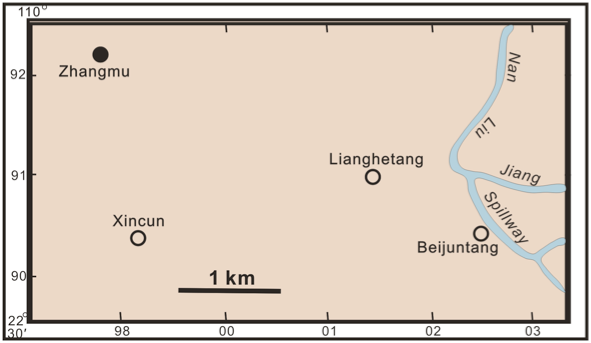Lianghetang Fm
Type Locality and Naming
The type section is located along both side of Nanliujiang channel nearby Beijuntang village, about 3 km east of Zhangmu Town, 35 km southeast of Yulin City, Guangxi. The name was proposed by Shi W.J. of Guangxi Regional Geological Survey in 1980
[Figure: Map showing the locations of the Beijuntan Fm, Lianghetang Fm and Zhangmu Fm in the Yulin area of Guangxi]
Lithology and Thickness
Sandy claystone. The Formation is mainly composed of gray-black mudstone and silty mudstone intercalated with some beds of thin bedded fine sandstone and quartz sandstone in the lower part. Due to the cover and fault the exposure of the formation is uncompleted. The thickness is more than 450 m.
Relationships and Distribution
Lower contact
Conformable on the Beijuntang Fm, with a 7.7 m-thick light-metamorphosed sandstone at the base.
Upper contact
Conformably overlain by the Zhangmu Fm
Regional extent
With restricted distribution it exposures only in the Yulin area, about 30 km extending from northeast to southwest.
GeoJSON
Fossils
The fossils of the formation is characterized by the graptolites and brachiopods. Graptolite includes Monogarptus telleri, Neomonograptus himalayensis, N. rigidus, Paleodictyola sp., Calograptus sp., Dendrograptus sp. Brachiopods are Howellella sp., Delthyris sp., Orientospirifer sp. Also seen are trilobites Graviocalymene sp., flora and fish fragments, bivalves, ostracods, crinoids and tenticulites.
Age
Depositional setting
The graptolites, dacryoconarids and pelagic ostracods have been regarded as indicators of deep marine basin and the other benthic fossils may be transported by current and reworked.
Additional Information
